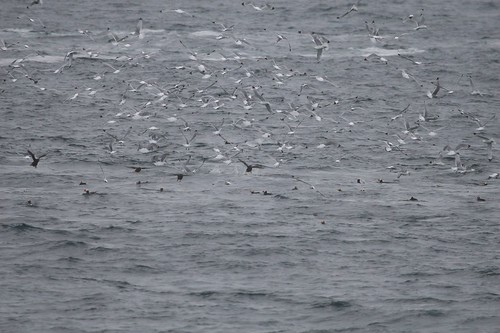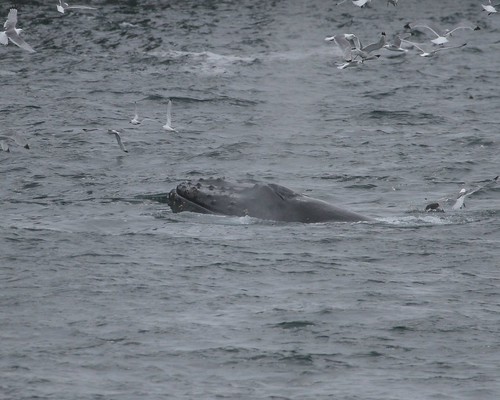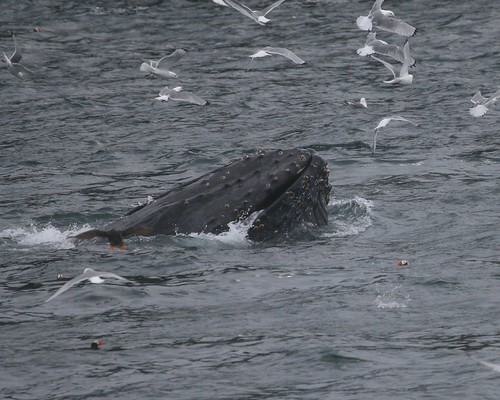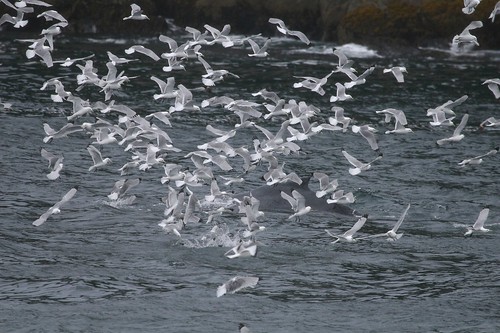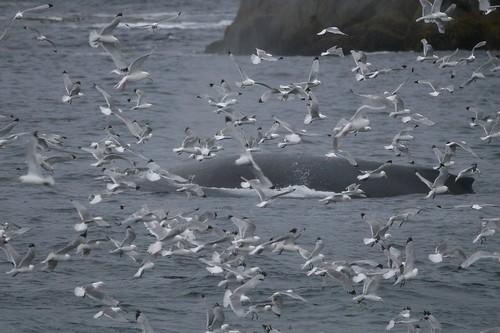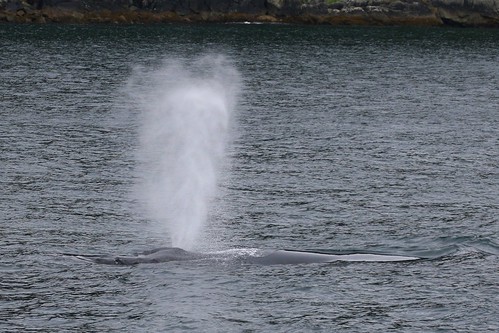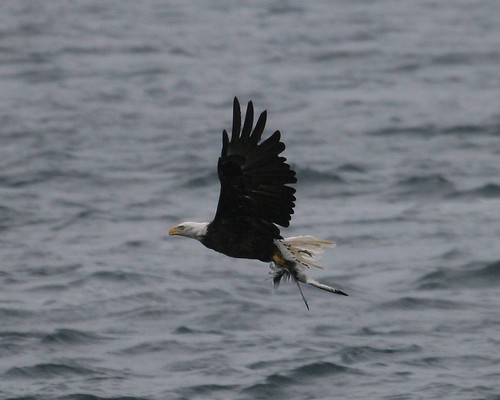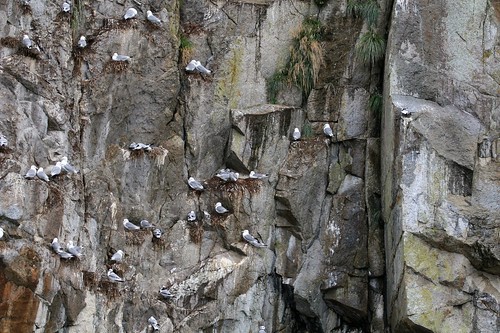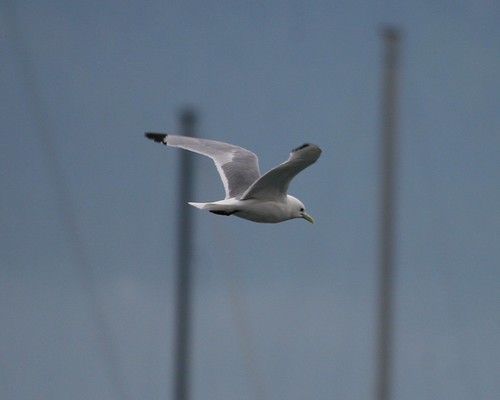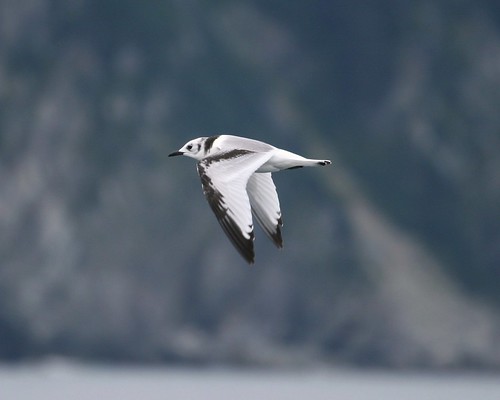On the way back from Aialik Glacier, the boat cruised by several more of those rocky islands that the birds enjoy so much. As we approached one hunk of rock, the captain noticed something that piqued his interest. All I saw, however, was a rather large flock of birds just above the surface of the water.
I didn't have to wait very long to understand. A Humpback Whale surfaced right where all those birds were flocking.
The birds and the whale were after the same thing: fish. The whale was fishing from below, and the birds from above.
I wonder if any birds, in an ill-timed attempt at a fish, have ever been eaten by a whale. I don't see how the whale could avoid any bird that got in the way. And there were enough Kittiwakes, Gulls and Puffins taking their chances for a fish that it just seems inevitable that one of those birds would eventually end up as a bit of whale chow. If one did, I am not sure how I would even notice.
Eventually the whale moved in one direction, and our boat moved in another. The birds seemed to settle down as well. I think that meant that there were no more fish to be had. We got a few more glimpses of the whale surfacing, spray puffing up into the air, before we headed on our way.
Showing posts with label Black-legged Kittiwake. Show all posts
Showing posts with label Black-legged Kittiwake. Show all posts
Bald Eagle Clutching Kittiwake
At one point on the Seward boat trip I noticed a Bald Eagle flying by. I whipped the camera into position and snapped a bunch of photos, barely realizing that the Eagle had something clutched in its talons. Later on that night (or maybe even the next week), as I reviewed the photos I had taken, I realized that the "something" in the Eagle's talons was a bird. Or what was left of a bird. Hard to say.
After some staring, and head scratching, I came to the highly speculative conclusion that the victim used to be a juvenile Black-legged Kittiwake. There were certainly enough of those around for the Eagle to choose from. Unfortunately, I did not see how this particular Kittiwake came to be in the possession of the Eagle, so we will all have to use our imagination.
After some staring, and head scratching, I came to the highly speculative conclusion that the victim used to be a juvenile Black-legged Kittiwake. There were certainly enough of those around for the Eagle to choose from. Unfortunately, I did not see how this particular Kittiwake came to be in the possession of the Eagle, so we will all have to use our imagination.
Black-legged Kittiwake
It sure is hard following up that last post with something just as exciting. After a little deliberation, I decided to post some pictures of Black-legged Kittiwake. Yeah...I agree. Kittiwakes are not nearly as exciting as an Orca breaching the surface in pursuit of a meal (if you didn't see that post, you should check it out).
Kittiwake. Such a fancy name for what is otherwise just another gull. I had to research it as I wrote this post, but it turns out that their name comes from the call they make. This one is the Black-legged variety (instead of the Red-legged variety), and it was a life bird for me. When we headed to Alaska, I was pretty sure I would end up seeing a Black-legged Kittiwake without really trying. I was right.
On our boat trip out of Seward, almost every gull we saw was a Black-legged Kittiwake. The boat trip took us past a few nesting locations. These were essentially small rock islands. If you imagine steep mountains that were, except for the very tip, submerged by water, then you can imagine the appearance of these islands. Only the birds found any use out of them, using any tiny bit of horizontal surface as a place to roost or nest.
The adults were fairly plain looking. White underneath, gray on top, a yellow bill with no black or red marks on it, and, of course, black legs. The tips of the wings were black with no white.
The first year birds, to me, had a much more interesting appearance. Their bills were black instead of yellow, and there were several spots and lines of black mixed in with the gray and white coloration.
Kittiwake. Such a fancy name for what is otherwise just another gull. I had to research it as I wrote this post, but it turns out that their name comes from the call they make. This one is the Black-legged variety (instead of the Red-legged variety), and it was a life bird for me. When we headed to Alaska, I was pretty sure I would end up seeing a Black-legged Kittiwake without really trying. I was right.
On our boat trip out of Seward, almost every gull we saw was a Black-legged Kittiwake. The boat trip took us past a few nesting locations. These were essentially small rock islands. If you imagine steep mountains that were, except for the very tip, submerged by water, then you can imagine the appearance of these islands. Only the birds found any use out of them, using any tiny bit of horizontal surface as a place to roost or nest.
The adults were fairly plain looking. White underneath, gray on top, a yellow bill with no black or red marks on it, and, of course, black legs. The tips of the wings were black with no white.
The first year birds, to me, had a much more interesting appearance. Their bills were black instead of yellow, and there were several spots and lines of black mixed in with the gray and white coloration.
Subscribe to:
Posts (Atom)
